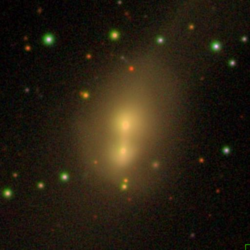Astronomy:Arp 166
| Arp 166 | |
|---|---|
 | |
| Observation data (J2000.0 epoch) | |
| Constellation | Triangulum |
| Right ascension | 01h 57m 32.00s [1] |
| Declination | +33° 12′ 24.00″ [1] |
| Redshift | 0.017529 [2] |
| Helio radial velocity | 5255 km/s [2] |
| Distance | 225 Mly[3] |
| Apparent magnitude (B) | 12.90 [1] |
| Characteristics | |
| Type | Pair of galaxies E0+E [2] |
| Apparent size (V) | 2.5 x 1.7 [2] |
| Other designations | |
| NGC 750, NGC 751 | |
Arp 166 is a pair of interacting elliptical galaxies approximately 225 million light-years away from Earth in the constellation of Triangulum.[2][3] The two galaxies, NGC 750 and NGC 751, are listed together as Arp 166 in the Atlas of Peculiar Galaxies (in the category Galaxies with diffuse filaments).[4]
Observational history
Arp 166 was discovered by German-born British astronomer William Herschel on September 12, 1784, but he did not resolve this close pair of galaxies, therefore he described it as a single object NGC 750.[4][3]
Arp 166 was first seen as a double by Irish engineer and astronomer Bindon Stoney on October 11, 1850, who used Lord Rosse's 72" telescope.[4] The second galaxy from this pair, which is smaller and fainter than NGC 750, was catalogued as NGC 751.[4]
Interacting galaxies
At least 100,000,000 years have passed since the moment of the first strong tidal perturbation between these two galaxies.[5] Both galaxies are characterized by strong tidal interactions and distortions, and they are still in the process of efficient tidal interaction.[5]
The distance between the centers of this pair is 21", or 10 kpc in projection.[6][5] Both galaxies have almost identical central radial velocities.[5] While NGC 750 exhibits nearly flat radial velocity curves, the radial velocity curves of NGC 751 are characterized by large variations of more than 100 km s−1 along the slit.[5]
A large, diffuse tidal tail extends 20 arcsec (10 kpc) to the north-east of the pair.[5]
References
- ↑ 1.0 1.1 1.2 "SIMBAD Astronomical Database". http://simbad.u-strasbg.fr/simbad/sim-id?Ident=arp+166&submit=submit+id. Retrieved March 7, 2019.
- ↑ 2.0 2.1 2.2 2.3 2.4 "NASA/IPAC Extragalactic Database". http://ned.ipac.caltech.edu/cgi-bin/objsearch?objname=arp+166. Retrieved March 7, 2019.
- ↑ 3.0 3.1 3.2 "Focal Pointe Observatory". http://bf-astro.com/ngc750/arp166.htm. Retrieved March 7, 2019.
- ↑ 4.0 4.1 4.2 4.3 "Data for NGC 750/751". http://www.astronomy-mall.com/Adventures.In.Deep.Space/NGC%201%20-%20999%20(11-30-17).htm. Retrieved March 7, 2019.
- ↑ 5.0 5.1 5.2 5.3 5.4 5.5 Madejsky, R. (1991). "Morphology and kinematics of the interacting elliptical galaxies NGC750 and NGC751 = ARP 166 - Velocity fields of tidally distorted elliptical galaxies". Astronomy and Astrophysics 247: 348–356. Bibcode: 1991A&A...247..348M.
- ↑ Sandage, A.; Bedke, J. (1994). The Carnegie Atlas of Galaxies. Volume I. Carnegie Institution of Washington. Bibcode: 1994cag..book.....S.
External links
- Arp 166 on WikiSky: DSS2, SDSS, GALEX, IRAS, Hydrogen α, X-Ray, Astrophoto, Sky Map, Articles and images
Coordinates: ![]() 01h 57m 32.00s, 33° 12′ 24.00″
01h 57m 32.00s, 33° 12′ 24.00″
 |

